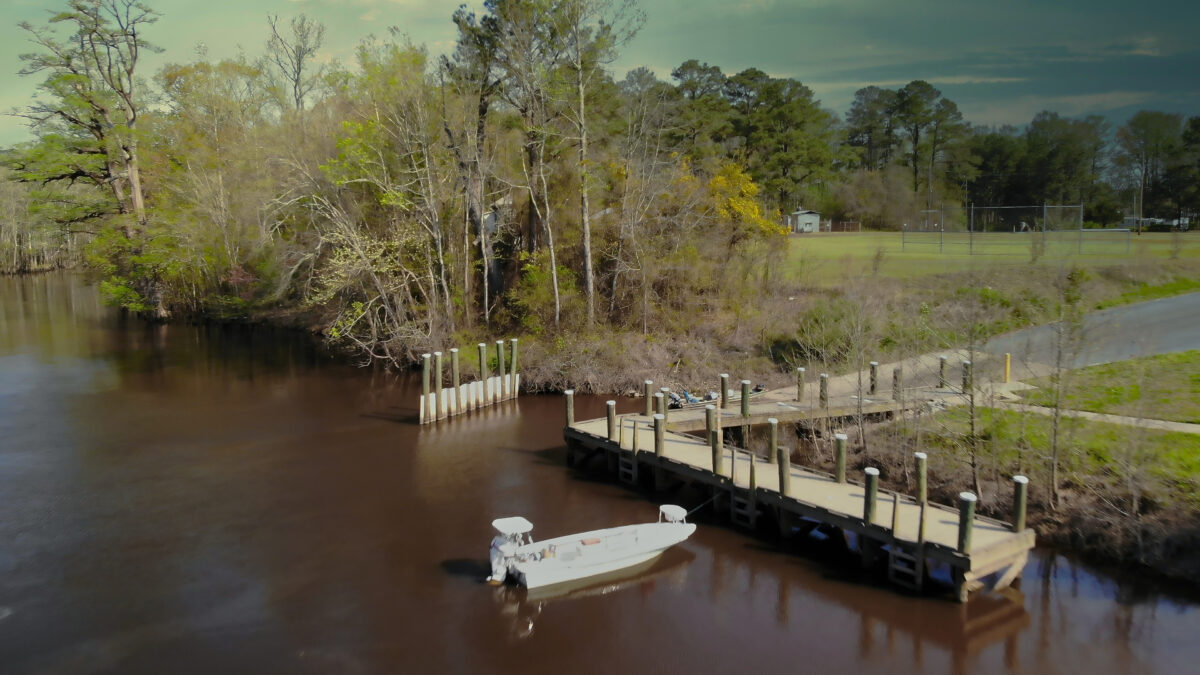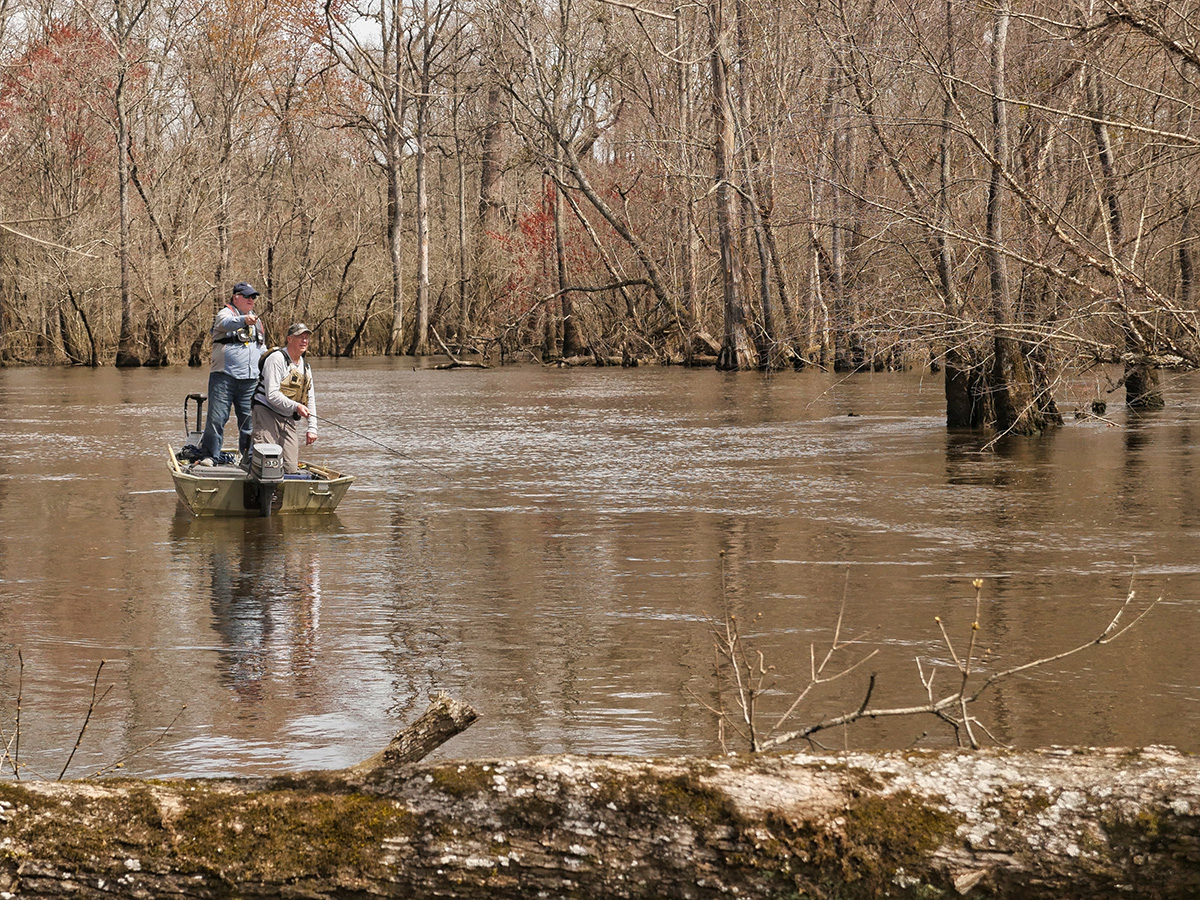By John Page Williams
Photos by Kendall Osborne
The Nottoway River is a Scenic River, so designated by Virginia’s Department of Conservation and Recreation (DCR). It’s a deceptively powerful, lovely jewel tucked away in Southside Virginia between the much larger James River watershed to the north and the also larger Roanoke River watershed to the south and west.
However, the Nottoway is actually 155 miles long, rising in the southeast corner of Prince Edward County. It winds through wooded bottomland swamps between six other counties before entering Southampton and diving toward the North Caroline line. A quarter-mile over the line, it joins the Blackwater River coming from the east to form the Chowan, flowing southeast to join the Roanoke at Edenton to fill Albemarle Sound. Thus, the Nottoway connects the southern part of Virginia’s Piedmont with the tidewater and the Atlantic.
This kind of dark water river, clear but colored by tannins from leaves and needles, was made to order for the lifeways of the Nottoway people who have lived along it for the past millennium and proudly still do. The upper river is shallow, with rocks and some Class I and II rapids, but it’s navigable by canoe and kayak, with multiple launch points and suggestions provided by the Department of Wildlife Resources (DWR).
Hercules Landing, the subject of this story, lies between and a few miles south of Courtland and Franklin. It’s named for the adjacent site of a former Hercules chemical plant, which is long gone. In fact, it is hard to believe that anything like that was ever sited beside this river, whose swampy banks are heavily wooded, with plenty of water-loving trees like swamp tupelo, swamp chestnut oak, red maple, and bald cypress.

Hercules landing on the Nottoway River.
Look at the river on Google Earth and you’ll get a sense of how the swamp and woods shield it from the surrounding land. They also filter rainwater and absorb floodwaters that would overflow banks with hard edges. The swamp is prime nesting habitat for a great variety of birds, including prothonotary warblers and wood ducks. It’s also home to secretive bobcats and river otters. Belted kingfishers, great and snowy egrets, great blue herons, and little green herons all fish along the channels and backwaters. Bald eagles, red-shouldered hawks, barred owls hunt the woods. A variety of woodpeckers, including the spectacular pileated, work on the trees.
The water here is tidal but fresh, and the river is made to order for paddling canoes and kayaks, for both fishing and birding. The concrete Hercules ramp accommodates any powerboat up to 20′ or so, though shallow-draft 14′-18′ skiffs with modest power are most appropriate. On our visit last spring, we rode with a friend in his 16′ flats skiff with 30-hp motor, which fitted the narrow channel well (it included a strong pushpole, just in case). A new pier along the water beside the ramp comes in handy for welcoming passengers aboard or waiting for another boat on the ramp at day’s end.
The Nottoway’s channel curves constantly through the surrounding swamp, with depths of eight to 12 feet in the straight reaches and holes of 15 to 20 feet in the turns. It pays to navigate carefully because of fallen and sometimes submerged trees that frequently impede the channel. That said, there’s no need for long runs, as the river is full of fish and bird habitat.
There’s no bad season to visit this part of the Nottoway, especially for anglers interested in the river’s wide variety of interesting fish. Note that DWR requires each angler to hold a freshwater fishing license for the entire river system, both nontidal and tidal. Also, be sure to check the season, bag, and length limits on the department’s website. Residents in the tidal section around the Hercules ramp include largemouth bass, black crappie, bluegills, redear sunfish (shellcrackers), yellow perch, and blue catfish. Through the year, casting small spoons, spinners, blade baits, and jigs with light gear will pick up a good variety. Let the lures sink in cool and warm weather and fish close to the surface as the sun warms the water in spring. Try worms and grass shrimp on the bottom and under bobbers for bream (bluegills and shellcrackers) and larger lures for bass. Cut bait draws in the catfish. In winter, look for Roanoke bass in deep holes around channel bends, using small minnows on bottom rigs. This fish is a close cousin to the rock bass or redeye, but its range is specific to the Chowan and Roanoke river systems.

Beginning in December and January, rockfish (striped bass), white perch, American shad, and hickory shad begin moving into the lower Nottoway to spawn upstream in March and April. Large minnows and jigs will work for the rockfish, but be sure to check the special regulations for the Nottoway. My friend with the flats skiff, who lives in Norfolk, makes it a point each spring to fish the Nottoway for shad from the Hercules landing. On our trip in early April, he ran upriver a couple of miles to a narrow spot and anchored with the current in eight feet of water.
There we caught and released a couple of dozen hard-fishing, acrobatic hickories and a powerful American shad apiece. He fished small, bright shad flies on a 5-wt. fly rod with a sink-tip line, often using roll casts because of the trees along the banks. I fished a light spinning rod with a double rig, a 1/8-oz., brightly-colored dart on a dropper with a tiny gold spoon trailing about 20” and a split shot halfway down the trailing leader. We caught fish both high and low in the current.
The Nottoway is unique among Virginia waterways, and it definitely merits its Scenic River designation. I’m looking forward to a return engagement at the Hercules landing this spring, as well as a late winter white perch trip.
Want more articles about boating and paddling in Virginia? Sign up for our monthly Boating email newsletter!
John Page Williams is a noted writer, angler, educator, naturalist, and conservationist. In more than 40 years at the Chesapeake Bay Foundation, Virginia native John Page championed the Bay’s causes and educated countless people about its history and biology.


